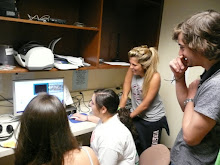round one: Composition
(layering and Z-axis using living subjects):
(layering and Z-axis using living subjects):
Layering and Z-axis: Chayna Schiff's scene. Notice the nice, tight cut-in that opens this scene and the second shot where the arm with the watch comes into frame. Also notice the layering using human subjects in background, midground, and foreground throughout the scene. A good example of layering is when we see the contrast of the winners and loser in the same shot starting at 1:34. This takes careful camera placement, shot composition, and direction by the filmmaker.
More layering student scenes can be seen at: http://www.sutelevision.com/2011/02/1.html and http://www.sutelevision.com/2011/10/nonverbal-scenes-for-fall-2011.htmlround two: Power Moves
Power Moves: Alyssa Kraus's scene. Pay attention to the long dolly shot at the opening of the scene down the DEG corridor. Alyssa took on the challenge of using our dolly to very good effect here. It gives the scene a nice momentum and puts us into the college cafe/student union building setting quite well. Also, look for the excellent layering shot at 1:40 when the characters in foreground and background are contrasted here. Nicely directed, Alyssa!
Power Moves: Kevin Collins's scene. Note Kevin's use of the wheelchair, available for production students to check out, at the opening of the scene. Kevin directed one subject to push the other subject out of frame at :51, which is an interesting use of off-screen space. Also, look for the series of shots in the middle of the scene(starting at about :54) when the two guys play basketball. There's a good pacing (of transitions) here and time is elided beautifully with the use of these dusk (magic hour) shots and the silhouette slow-motion shot of the player shooting the basketball.
Power Moves: Rachel Mack's scene. The subject matter here has a sweetness that is charming. Rachel's protagonist has a fun, highly-watchable screen presence here, especially as he runs through the landscape, from left to right, flailing his arms above his head (at 1:09). Actors who are willing to do what you ask them to do (especially things that may seem silly or crazy) are worth their weight in gold, we're finding out in this class, aren't we? Also look for her well-timed cuts when the guy trips over the Panda and falls to the ground (1:11).
More power moves student scenes can be seen at: http://www.sutelevision.com/2011/02/1.html and http://www.sutelevision.com/2011/10/nonverbal-scenes-for-fall-2011.html
More power moves student scenes can be seen at: http://www.sutelevision.com/2011/02/1.html and http://www.sutelevision.com/2011/10/nonverbal-scenes-for-fall-2011.html
round three: Subjective Camera
Subjective Camera: Trevor Polly's scene. Watch for the interesting use of Z-axis and off-screen space starting at :29 (the shadowy character moves through the frame, in, around, and off screen. Imitate this by letting your actors move through the frame and then past the frame, off camera). Also notice the interesting high-angle OTS zoom-out looking down on the subject starting at 1:23.
Subjective Camera: Tom Vollkommer's scene (Audio was disabled by YouTube.) Notice the visually interesting layering in this scene at 1:36 when subjects walk from right to left in background and foreground. Also look for the great POV shot at 2:18 when would-be killer looks down at his victim and then moves to suffocate him.
Subjective Camera: Katie Manley's scene. Look for the flashback starting at :21 where the two subjects enter the house as if they've just escaped from the pit of hell (aided by the brightness effects here). Also notice the repeated cut on the word "shots" of the drinking, implying that the action occurs again and again.
More subjective camera student scenes can be seen at: http://www.sutelevision.com/2011/02/1.html and http://www.sutelevision.com/2011/10/nonverbal-scenes-for-fall-2011.html
round four: Cutaways and Cut-ins
Cutaways and Cut-ins: Shane Barry's scene. Notice how Shane's scene opens on two cutaways that help establish the location. If this were a scene in a larger project, we can assume that the shot of the building is a transition that sets up the new scene that is now about to take place. The shot of the door with the room number serves as both a cutaway and a cut-in because it further defines the location. We correctly assume that the guy we see in the next shot is in that room, as is intended by the filmmaker.
Cutaways and Cut-ins: James Costello's scene. There are a lot of nice cut-ins here (the TV, the microwave timer, etc.). Look for a particularly well-composed shot at 2:06 when the subject opens the microwave, bends down so her face comes into the shot (and is charmingly illuminated by the microwave interior light) and then goes out of frame.
Cutaways and Cut-ins: Kyle Stover's scene.
More cutaways/cut-ins student scenes can be seen at: http://www.sutelevision.com/2011/02/1.html and http://www.sutelevision.com/2011/10/nonverbal-scenes-for-fall-2011.html





















